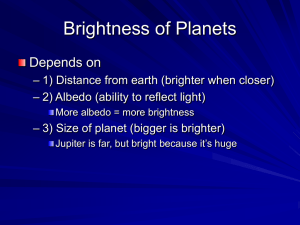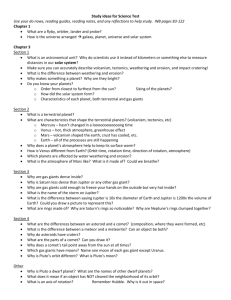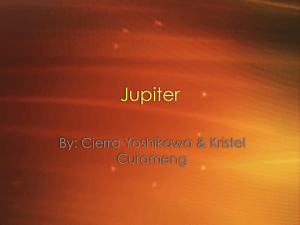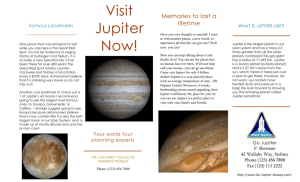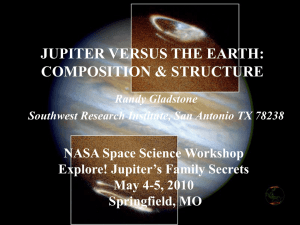Bizarre, colorful clouds of methane and ammonia compounds ripple through... n atmosphere. When we look at Jupiter, whether it be...
advertisement
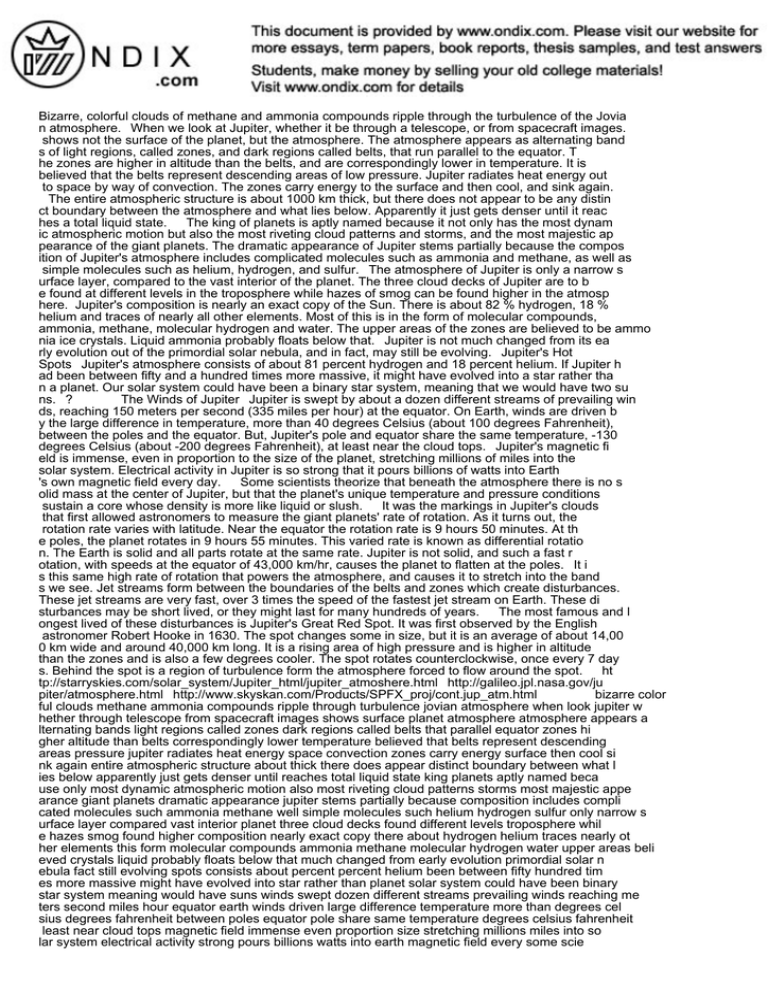
Bizarre, colorful clouds of methane and ammonia compounds ripple through the turbulence of the Jovia n atmosphere. When we look at Jupiter, whether it be through a telescope, or from spacecraft images. shows not the surface of the planet, but the atmosphere. The atmosphere appears as alternating band s of light regions, called zones, and dark regions called belts, that run parallel to the equator. T he zones are higher in altitude than the belts, and are correspondingly lower in temperature. It is believed that the belts represent descending areas of low pressure. Jupiter radiates heat energy out to space by way of convection. The zones carry energy to the surface and then cool, and sink again. The entire atmospheric structure is about 1000 km thick, but there does not appear to be any distin ct boundary between the atmosphere and what lies below. Apparently it just gets denser until it reac hes a total liquid state. The king of planets is aptly named because it not only has the most dynam ic atmospheric motion but also the most riveting cloud patterns and storms, and the most majestic ap pearance of the giant planets. The dramatic appearance of Jupiter stems partially because the compos ition of Jupiter's atmosphere includes complicated molecules such as ammonia and methane, as well as simple molecules such as helium, hydrogen, and sulfur. The atmosphere of Jupiter is only a narrow s urface layer, compared to the vast interior of the planet. The three cloud decks of Jupiter are to b e found at different levels in the troposphere while hazes of smog can be found higher in the atmosp here. Jupiter's composition is nearly an exact copy of the Sun. There is about 82 % hydrogen, 18 % helium and traces of nearly all other elements. Most of this is in the form of molecular compounds, ammonia, methane, molecular hydrogen and water. The upper areas of the zones are believed to be ammo nia ice crystals. Liquid ammonia probably floats below that. Jupiter is not much changed from its ea rly evolution out of the primordial solar nebula, and in fact, may still be evolving. Jupiter's Hot Spots Jupiter's atmosphere consists of about 81 percent hydrogen and 18 percent helium. If Jupiter h ad been between fifty and a hundred times more massive, it might have evolved into a star rather tha n a planet. Our solar system could have been a binary star system, meaning that we would have two su ns. ? The Winds of Jupiter Jupiter is swept by about a dozen different streams of prevailing win ds, reaching 150 meters per second (335 miles per hour) at the equator. On Earth, winds are driven b y the large difference in temperature, more than 40 degrees Celsius (about 100 degrees Fahrenheit), between the poles and the equator. But, Jupiter's pole and equator share the same temperature, -130 degrees Celsius (about -200 degrees Fahrenheit), at least near the cloud tops. Jupiter's magnetic fi eld is immense, even in proportion to the size of the planet, stretching millions of miles into the solar system. Electrical activity in Jupiter is so strong that it pours billions of watts into Earth 's own magnetic field every day. Some scientists theorize that beneath the atmosphere there is no s olid mass at the center of Jupiter, but that the planet's unique temperature and pressure conditions sustain a core whose density is more like liquid or slush. It was the markings in Jupiter's clouds that first allowed astronomers to measure the giant planets' rate of rotation. As it turns out, the rotation rate varies with latitude. Near the equator the rotation rate is 9 hours 50 minutes. At th e poles, the planet rotates in 9 hours 55 minutes. This varied rate is known as differential rotatio n. The Earth is solid and all parts rotate at the same rate. Jupiter is not solid, and such a fast r otation, with speeds at the equator of 43,000 km/hr, causes the planet to flatten at the poles. It i s this same high rate of rotation that powers the atmosphere, and causes it to stretch into the band s we see. Jet streams form between the boundaries of the belts and zones which create disturbances. These jet streams are very fast, over 3 times the speed of the fastest jet stream on Earth. These di sturbances may be short lived, or they might last for many hundreds of years. The most famous and l ongest lived of these disturbances is Jupiter's Great Red Spot. It was first observed by the English astronomer Robert Hooke in 1630. The spot changes some in size, but it is an average of about 14,00 0 km wide and around 40,000 km long. It is a rising area of high pressure and is higher in altitude than the zones and is also a few degrees cooler. The spot rotates counterclockwise, once every 7 day s. Behind the spot is a region of turbulence form the atmosphere forced to flow around the spot. ht tp://starryskies.com/solar_system/Jupiter_html/jupiter_atmoshere.html http://galileo.jpl.nasa.gov/ju piter/atmosphere.html http://www.skyskan.com/Products/SPFX_proj/cont.jup_atm.html bizarre color ful clouds methane ammonia compounds ripple through turbulence jovian atmosphere when look jupiter w hether through telescope from spacecraft images shows surface planet atmosphere atmosphere appears a lternating bands light regions called zones dark regions called belts that parallel equator zones hi gher altitude than belts correspondingly lower temperature believed that belts represent descending areas pressure jupiter radiates heat energy space convection zones carry energy surface then cool si nk again entire atmospheric structure about thick there does appear distinct boundary between what l ies below apparently just gets denser until reaches total liquid state king planets aptly named beca use only most dynamic atmospheric motion also most riveting cloud patterns storms most majestic appe arance giant planets dramatic appearance jupiter stems partially because composition includes compli cated molecules such ammonia methane well simple molecules such helium hydrogen sulfur only narrow s urface layer compared vast interior planet three cloud decks found different levels troposphere whil e hazes smog found higher composition nearly exact copy there about hydrogen helium traces nearly ot her elements this form molecular compounds ammonia methane molecular hydrogen water upper areas beli eved crystals liquid probably floats below that much changed from early evolution primordial solar n ebula fact still evolving spots consists about percent percent helium been between fifty hundred tim es more massive might have evolved into star rather than planet solar system could have been binary star system meaning would have suns winds swept dozen different streams prevailing winds reaching me ters second miles hour equator earth winds driven large difference temperature more than degrees cel sius degrees fahrenheit between poles equator pole share same temperature degrees celsius fahrenheit least near cloud tops magnetic field immense even proportion size stretching millions miles into so lar system electrical activity strong pours billions watts into earth magnetic field every some scie ntists theorize beneath there solid mass center unique pressure conditions sustain core whose densit y more like liquid slush markings clouds first allowed astronomers measure giant planets rate rotati on turns rotation rate varies with latitude near rotation rate hours minutes poles rotates hours min utes this varied known differential earth solid parts rotate same solid such fast with speeds causes flatten poles this same high powers causes stretch bands streams form boundaries which create distu rbances these streams very fast over times speed fastest stream these disturbances short lived they might last many hundreds years famous longest lived these disturbances great spot first observed eng lish astronomer robert hooke spot changes some size average wide around long rising area high pressu re higher altitude also cooler spot rotates counterclockwise once every days behind region turbulenc e form forced flow around http starryskies html atmoshere html http galileo nasa html http skyskan p roducts spfx proj contEssay, essays, termpaper, term paper, termpapers, term papers, book reports, s tudy, college, thesis, dessertation, test answers, free research, book research, study help, downloa d essay, download term papers
